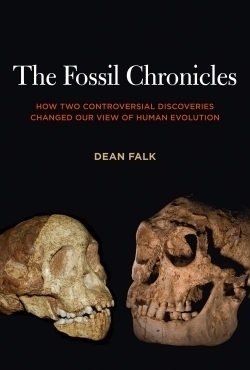The Fossil Chronicles
How Two Controversial Discoveries Changed Our View of Human Evolution
In her latest book, Dean Falk notes, “when it comes to the subject of human origins, scientists have been every bit as passionate about their convictions as religious fundamentalists.” In this accessible, informative account of the discoveries of two early human fossils, the author details the scientific shifts these finds caused and the “paleopolitics” surrounding them.
She begins with the 1924 discovery of the Taung child, a two-million-year-old skull located in South Africa by a young anatomist, Raymond Dart. Although now recognized as belonging to a crucial family of early humans, the australopithecines, it contradicted many accepted tenets of human evolution. The fossil was found in Africa instead of Asia, the assumed “cradle of humanity.” Even more importantly, its brain was smaller than expected for a potential missing link. The assumption that “brain size led the way” was fueled in part by the fraudulent “Piltdown Man,” a man-made “fossil” combining a larger human braincase with an ape jawbone, which would not be exposed as a hoax until 1953. Dart’s initial discovery was published in Nature in 1925, the same year as the famous Scopes trial. Even though Dart’s argument for the evolutionary importance of the Taung child would prove to be correct, he faced intense opposition and skepticism from both religious fundamentalists and his own colleagues, causing him to abandon his full manuscript, which still sits unpublished.
In the second half of the book, Falk describes her own encounter with “paleopolitics” as one of the key researchers on another revolutionary discovery, in 2004, of a three-foot-tall adult woman who lived about 18,000 years ago on an Inonesian island. The “Hobbit” has caused a controversy every bit as heated as the earlier one, with the debate again centering on her surprisingly small braincase. Falk argues that she represents a new species, living concurrently with homo erectus, whose small size may be explained by the so-called “island dwarfism” effect. Others claim that she could not have had the brain capacity to make the stone tools found near her and that she may simply have been a modern human afflicted by disease. Hobbit’s true origin is still a matter of debate.
The Fossil Chronicles is a fascinating description of two extraordinary finds in a field that continues to hold the attention of scientists and laypeople alike. Falk’s well-researched explanation of the build-up and controversy regarding the Taung child is both a window into the thinking of early-twentieth-century scientists and a remarkable profile of the individual scholars involved. Her story can get bogged down by the mundane details of her own experience with the Hobbit discovery, yet, overall, the author’s account of the recent find is equally enthralling. Falk’s clear yet comprehensive descriptions of evolutionary theories and techniques make this book perfect for both neophytes and those well-versed in human evolution. The book may not answer the big question of where we come from, but it gives some valuable insight into the ways modern humans have reacted to and explained the remains of our ancestors.
Reviewed by
Claire Posner
Disclosure: This article is not an endorsement, but a review. The publisher of this book provided free copies of the book to have their book reviewed by a professional reviewer. No fee was paid by the publisher for this review. Foreword Reviews only recommends books that we love. Foreword Magazine, Inc. is disclosing this in accordance with the Federal Trade Commission’s 16 CFR, Part 255.

